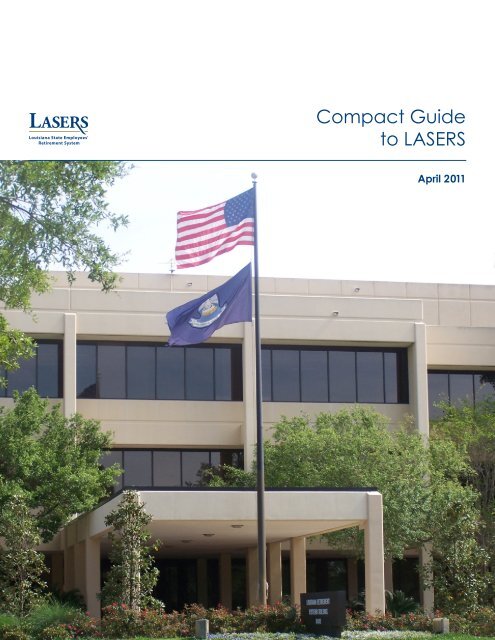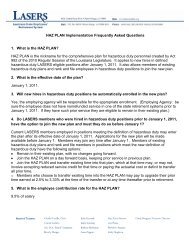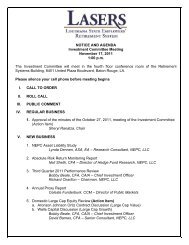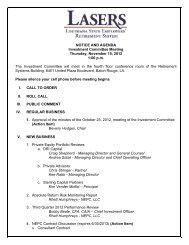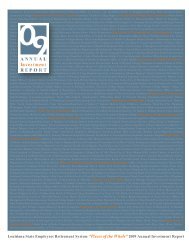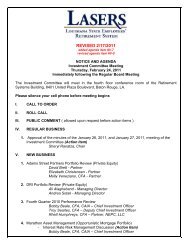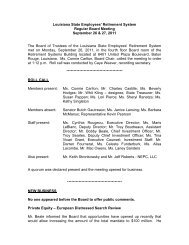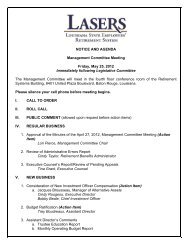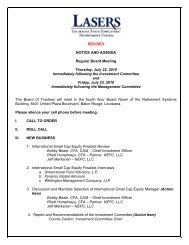Compact Guide to LASERS - Louisiana State Employees ...
Compact Guide to LASERS - Louisiana State Employees ...
Compact Guide to LASERS - Louisiana State Employees ...
Create successful ePaper yourself
Turn your PDF publications into a flip-book with our unique Google optimized e-Paper software.
<strong>Compact</strong> <strong>Guide</strong><br />
<strong>to</strong> <strong>LASERS</strong><br />
April 2011
<strong>Compact</strong> <strong>Guide</strong> <strong>to</strong> <strong>LASERS</strong><br />
1<br />
Table of<br />
Contents<br />
His<strong>to</strong>ry, Structure, and Funding<br />
Recent Issues<br />
His<strong>to</strong>ry, Membership, Benefit Formula................................2<br />
Investment Earnings.............................................................2<br />
Market vs. Actuarial Rate of Return...................................3<br />
Employee Contributions......................................................3<br />
<strong>State</strong> (Employer) Contributions...........................................4<br />
Fiscal and Financial Impact................................................5<br />
Consolidation........................................................................6<br />
Cost Analysis..............................................................6<br />
Effect on UAL.............................................................7<br />
Bigger Does Not Mean Better..................................7<br />
Board/Governance..................................................8<br />
Key Consolidation Concerns...................................9<br />
Defined Benefit & Defined Contribution..........................10<br />
Unfunded Accrued Liability (Debt)..................................12<br />
What is the IUAL/UAL............................................12<br />
Steps Taken <strong>to</strong> Address the UAL............................13<br />
Chart: UAL Payment Schedule..............................14<br />
Deferred Retirement Option Program.............................15<br />
Keeping <strong>LASERS</strong> on the Right Track ...................................................................................17<br />
Appendix<br />
Exhibit A – Membership Categories.................................18<br />
(accrual rate, contribution rate, eligibility)<br />
Exhibit B – Defined Benefit Reforms..................................21<br />
Exhibit C – <strong>LASERS</strong> Plans and Enabling Legislation.........23<br />
Exhibit D – System Snapshot of <strong>LASERS</strong>............................24
2 <strong>Compact</strong> <strong>Guide</strong> <strong>to</strong> <strong>LASERS</strong><br />
His<strong>to</strong>ry,<br />
Structure<br />
and Funding<br />
The <strong>Louisiana</strong> <strong>State</strong> <strong>Employees</strong>’ Retirement System (<strong>LASERS</strong>), a qualified defined benefit pension<br />
plan, was created in 1946. <strong>LASERS</strong> membership includes rank & file state employees and special<br />
plans for: judges, certain legislative officials and statewide elected officials, correctional officers in<br />
the Department of Public Safety and Corrections, bridge police for the Crescent City Connection,<br />
enforcement agents with the Department of Wildlife and Fisheries, Alcohol and Tobacco Control<br />
officers, and peace officers.<br />
Retirement benefits are paid monthly for the retiree’s lifetime and are calculated based on the following<br />
formula:<br />
accrual rate x years of service credit x final average compensation<br />
The accrual rate varies for each benefit group depending on dates and type of service. See Appendix:<br />
Exhibit A for a listing of accrual rates by membership category.<br />
Funding for <strong>LASERS</strong> benefits comes from three sources:<br />
●●<br />
<strong>LASERS</strong> Investment Earnings<br />
●●<br />
Employee Contributions<br />
●●<br />
<strong>State</strong> (Employer) Contributions<br />
<strong>LASERS</strong> Investment Earnings<br />
Returns generated from <strong>LASERS</strong> investments make up the largest portion of funding. Over the past 20<br />
years, <strong>LASERS</strong> investment earnings have contributed over 41% of revenue. In FY 2010, <strong>LASERS</strong> investment<br />
earnings accounted for more than 62% of revenue.<br />
<strong>LASERS</strong> Revenue<br />
1991-2010 (20 years)<br />
<strong>LASERS</strong> Revenue<br />
FY 2010<br />
Other <strong>State</strong><br />
Contributions<br />
0.7%<br />
<strong>State</strong> Debt<br />
Contribution<br />
22.2%<br />
<strong>State</strong> Benefit<br />
Contribution<br />
16.0%<br />
Employee<br />
Contributions<br />
11.1%<br />
<strong>State</strong> Debt<br />
Contribution<br />
16.0%<br />
<strong>State</strong> Benefit<br />
Contribution<br />
10.4%<br />
Employee<br />
Contributions<br />
19.4%<br />
<strong>LASERS</strong><br />
Investment<br />
Earnings<br />
41.8%<br />
<strong>LASERS</strong><br />
Investment<br />
Earnings<br />
62.5%
<strong>Compact</strong> <strong>Guide</strong> <strong>to</strong> <strong>LASERS</strong> | His<strong>to</strong>ry, Structure and Funding<br />
3<br />
<strong>LASERS</strong> investment program posted impressive market gains for FYE 2010, and has also proven effective<br />
over the long term.<br />
●●<br />
Investment return of 16.1% as of Fiscal Year End 2010<br />
<strong>LASERS</strong> in-house investment staff manages approximately 30% of investments, saving millions of dollars<br />
per year versus active outside management.<br />
<strong>LASERS</strong> Investments as of 1/31/2011<br />
Total Assets<br />
$8.984 billion<br />
Fiscal Year <strong>to</strong> Date (July 1 – January 31) 18.7%<br />
<strong>LASERS</strong> market returns are more than just a component of funding. They play a large part in determining<br />
<strong>LASERS</strong> actuarial rate of return as well.<br />
The market gains or losses are smoothed by gradually recognizing the change in value of these assets<br />
over a four year period. The “smoothed” value is the actuarial value of assets.<br />
The funding of the system assumes that <strong>LASERS</strong> actuarial rate of return will be 8.25%. If the actuarial return<br />
is less than 8.25%, the deficit must be recouped through future state contributions. If the actuarial return<br />
exceeds 8.25%, the excess interest earnings are used <strong>to</strong> “credit” future state contributions. Theoretically,<br />
if the 8.25% target is achieved on average, these credit and deficit payments will average zero over<br />
the long-run.<br />
●●<br />
As of FYE 2009 - <strong>LASERS</strong> 25 year compounded actuarial return average is 8.41%.<br />
●●<br />
As of FYE 2010 - <strong>LASERS</strong> 26 year compounded actuarial return average is 8.17%.<br />
►►<br />
<strong>LASERS</strong> has exceeded the assumed 8.25% actuarial return in 19 of the past 26 years.<br />
►►<br />
From February 2009 through mid-February 2011, <strong>LASERS</strong> has added over $3 billion <strong>to</strong> our fund.<br />
Employee Contributions<br />
<strong>State</strong> employees pay a percentage of their salary <strong>to</strong>ward their own retirement benefit. The following<br />
table shows the employee contribution rates for new hires beginning January 1, 2011.<br />
For a complete listing of employee contribution rates for all <strong>LASERS</strong> membership categories, please see<br />
Appendix: Exhibit A.<br />
Rank and File Members 8.0%<br />
Hazardous Duty Members 9.5%<br />
Judges 13.0%
4 His<strong>to</strong>ry, Structure and Funding | <strong>Compact</strong> <strong>Guide</strong> <strong>to</strong> <strong>LASERS</strong><br />
<strong>State</strong> (Employer) Contributions<br />
From the beginning, benefits through <strong>LASERS</strong> were granted, but not fully funded by the <strong>State</strong> of <strong>Louisiana</strong>.<br />
As an example, the table below shows the contribution (as a percentage of payroll) necessary <strong>to</strong> fully<br />
fund benefits versus the lesser amount paid by the <strong>State</strong> annually from 1959 <strong>to</strong> 1968 and 1983 <strong>to</strong> 1991. 1<br />
FYE 1959 1960 1961 1962 1963 1964 1965 1966 1967 1968 1969<br />
<strong>State</strong><br />
Contribution<br />
Required<br />
<strong>State</strong><br />
Contribution<br />
Received<br />
9.8% 11.81% 9.53% 9.91% 12.26% 11.51% 11.04% 11.98% 11.09% 11.09% 11.18%<br />
6.0% 6.0% 6.0% 6.0% 6.0% 8.0% 8.0% 8.0% 8.0% 8.0% 8.0%<br />
FYE 1983 1984 1985 1986 1987 1988 1989 1990 1991<br />
<strong>State</strong><br />
Contribution<br />
Required<br />
<strong>State</strong><br />
Contribution<br />
Received<br />
10.96% 10.94% 10.85% 12.11% 12.5% 12.4% 12.22% 14.09% 12.70%<br />
9.2% 9.2% 9.2% 10.2% 10.2% 11.2% 11.2% 7.80% 10.7%<br />
The many years of insufficient contributions from the <strong>State</strong> resulted in a large initial unfunded accrued<br />
liability (IUAL, or initial debt). A 1987 Constitutional Amendment required the <strong>State</strong> <strong>to</strong> begin paying the<br />
full contribution necessary <strong>to</strong> fund the normal cost of benefits for <strong>LASERS</strong> members and <strong>to</strong> amortize the<br />
initial debt for payment by 2029. Other fac<strong>to</strong>rs have also contributed <strong>to</strong> the System’s <strong>to</strong>tal unfunded<br />
accrued liability (UAL, or <strong>to</strong>tal debt), including interest on the initial debt, investment losses, changes in<br />
assumptions, and benefit enhancements granted by the Legislature without funding.<br />
Because of this, the <strong>State</strong> contribution consists of two components: accruing benefits and the debt<br />
payment. The debt payment makes up the greatest percentage of the <strong>State</strong>’s contributions each<br />
year. As an example, for the 2010-2011 fiscal year, the <strong>to</strong>tal <strong>State</strong> contribution of 22% consists of 6.56%<br />
for the cost of employee benefits and 15.44% for the debt payment. That means over 70% of what the<br />
state paid <strong>to</strong> <strong>LASERS</strong> that year was for the debt.<br />
FY 2010-2011 Breakdown<br />
of <strong>State</strong> Contribution<br />
Cost of<br />
Benefits<br />
29.8%<br />
1<br />
<strong>State</strong> Contribution Required and <strong>State</strong> Contribution Received<br />
data for 1959-1969 was compiled using his<strong>to</strong>rical documents<br />
at <strong>LASERS</strong>, and should be taken as approximate. This data for<br />
1970-1982 is not available. This data for 1983-1991 is supported by<br />
<strong>LASERS</strong> actuarial valuations.<br />
Debt<br />
Payment<br />
70.2%
<strong>Compact</strong> <strong>Guide</strong> <strong>to</strong> <strong>LASERS</strong> | His<strong>to</strong>ry, Structure and Funding<br />
5<br />
Fiscal and Financial Impact<br />
There is a misconception that employer contributions <strong>to</strong> <strong>LASERS</strong> comprise a significant portion of the<br />
<strong>State</strong> operating budget. In fact, <strong>State</strong> payments <strong>to</strong> the retirement system are approximately 2% of the<br />
overall operating budget.<br />
FY 2010-2011 <strong>State</strong> Contribution<br />
as Fraction of <strong>State</strong> Budget 2<br />
<strong>State</strong><br />
Budget<br />
Total <strong>State</strong> Contribution<br />
<strong>to</strong> <strong>LASERS</strong> as Fraction<br />
of <strong>State</strong> Budget<br />
2.2%<br />
Additionally, <strong>LASERS</strong> continues <strong>to</strong> be a major economic driver for our <strong>State</strong>.<br />
●●<br />
<strong>LASERS</strong> paid more than $860 million in benefits and refunds in FY 2010.<br />
●●<br />
Over 90% of <strong>LASERS</strong> retirees live in <strong>Louisiana</strong>, resulting in a $782 million impact on our <strong>State</strong> and<br />
home<strong>to</strong>wn economies.<br />
●●<br />
<strong>LASERS</strong> invests over $230 million in <strong>Louisiana</strong> companies.<br />
It is also important <strong>to</strong> keep in mind that the average rank and file benefit is only $19,140 per year.<br />
<strong>LASERS</strong> members do not participate in Social Security. <strong>LASERS</strong> ensures their retirement security.<br />
2<br />
FY 2010-2011 Total <strong>Louisiana</strong> Budget – General Appropriations ($27,002,190,991)
6 Recent Issues: Consolidation<br />
<strong>Compact</strong> <strong>Guide</strong> <strong>to</strong> <strong>LASERS</strong><br />
Recent Issues:<br />
Consolidation<br />
A financial analysis shows that consolidation of the systems is neither cost effective nor beneficial <strong>to</strong> the<br />
systems or the <strong>State</strong> of <strong>Louisiana</strong>.<br />
Cost Analysis<br />
Transaction costs associated with merging $9 billion in assets in<strong>to</strong> a larger fund could have an upfront<br />
cost conservatively of $30 million <strong>to</strong> $44 million. Transaction costs associated with combining $23 billion<br />
in assets could easily cost up <strong>to</strong> $170 million.<br />
Even if the systems were able <strong>to</strong> achieve additional economies of scale of up <strong>to</strong> 15 basis points. Such a<br />
savings for a $9 billion plan would amount <strong>to</strong> $4.5 million. For a $23 billion plan, the savings would likely<br />
be no more than $18 million at best.<br />
Any economies of scale savings would be offset 10 <strong>to</strong> 1 by the immediate upfront costs.<br />
Each retirement system manages an investment pool for the sole purpose of funding the liabilities of<br />
the respective system. Each system has an actuarial target rate of return set by the Public Retirement<br />
Systems’ Actuarial Committee (<strong>LASERS</strong> is 8.25%), and the asset allocation of the system is framed based<br />
on such rate.<br />
<strong>LASERS</strong> investment fund benefits from a sophisticated asset allocation including both traditional and<br />
alternative assets. At first glance, it seems that there could be economies of scale resulting in fee<br />
savings and higher returns if the assets were combined. However, this is not the case.<br />
●●<br />
No more than 50% of system assets can be consolidated. Assets that cannot be consolidated<br />
include:<br />
♦♦<br />
♦♦<br />
♦♦<br />
Approximately 30% of the portfolio internally managed, saving $6 million annually.<br />
Alternative assets/private partnerships such as real estate, private equity, etc.<br />
Constrained asset classes such as small cap equity and emerging market equity.<br />
●●<br />
●●<br />
Remaining Assets – Includes efficient asset classes such as domestic and international large<br />
cap equity, core fixed income, etc. which provides little cost savings by consolidation. Adding<br />
additional dollars <strong>to</strong> a fewer number of investment managers does not drastically reduce<br />
investment management fees.<br />
A significant impact of consolidating investment programs would be increased investment risk,<br />
having a larger number of assets with fewer managers.
<strong>Compact</strong> <strong>Guide</strong> <strong>to</strong> <strong>LASERS</strong> | Recent Issues: Consolidation<br />
7<br />
Effect on Unfunded Accrued Liability<br />
●●<br />
●●<br />
No reduction.<br />
Constitutional requirement: payment of system debt and financial soundness.<br />
Bigger Does Not Mean Better<br />
●●<br />
Consolidation does not ensure higher returns. <strong>LASERS</strong> returns, as an unconsolidated system, are<br />
among the highest in the nation.<br />
♦♦<br />
Ranked in the <strong>to</strong>p 3% of all public pension plans with market values greater than $1 billion in<br />
the Trust Universe Comparison Service (TUCS) for the 1 year period ending 12/31/2010<br />
▪▪<br />
<strong>LASERS</strong> long term TUCS rankings: five years - <strong>to</strong>p 13%; ten years - <strong>to</strong>p 17%.<br />
♦♦<br />
Comparison <strong>to</strong> Large Public Pension Systems:<br />
▪▪<br />
<strong>LASERS</strong> outperformed the largest retirement system in the country, CalPERS.<br />
System<br />
FYE 6/30/10<br />
Return<br />
Assets as of<br />
FYE 6/30/10<br />
<strong>LASERS</strong> 16.1% $7.7 billion<br />
CalPERS 11.4% $200.0 billion<br />
CalSTERS 12.2% $129.7 billion<br />
Florida<br />
Retirement System<br />
14.0% $109.3 billion<br />
TRSL 11.6% $11.9 billion<br />
MOSERS 14.3% $7.0 billion<br />
<strong>LASERS</strong> investments fees are lower than the average paid by state retirement systems<br />
●●<br />
●●<br />
A study conducted by Greenwich Associates surveyed 80 state retirement systems regarding<br />
fees paid <strong>to</strong> traditional outside investment managers in 2008. The average fee paid <strong>to</strong> traditional<br />
outside managers was 39.5 basis points (0.395%), while <strong>LASERS</strong> paid 35.8 basis points, lower than<br />
the average.<br />
In addition, <strong>LASERS</strong> manages approximately 30% of the portfolio internally, saving approximately<br />
$6 million in management fees each year. When <strong>LASERS</strong> internal management is fac<strong>to</strong>red in,<br />
<strong>LASERS</strong> averages 21.4 basis points in management fees.
8 Recent Issues: Consolidation | <strong>Compact</strong> <strong>Guide</strong> <strong>to</strong> <strong>LASERS</strong><br />
Boards/Governance<br />
●●<br />
●●<br />
●●<br />
●●<br />
Current structure works as reflected by investment performance noted above.<br />
Issues of representation – system members are given a lower proportional representation with a<br />
consolidated board.<br />
Would appointees have conflicts of interest or the requisite experience<br />
A consolidated board, even without the consolidation of investments will tend <strong>to</strong> make similar<br />
decision which would cost the system the value of individual scrutiny and attention <strong>to</strong> plan<br />
specifics and needs – this creates additional risk.<br />
♦♦<br />
Such decisions eliminate diversification – both in actual asset allocation and diversification<br />
across investment managers – this creates additional risk.<br />
<strong>LASERS</strong> has a highly qualified investment staff.<br />
●●<br />
●●<br />
●●<br />
●●<br />
●●<br />
Eight investment professionals, all hold a Masters in Finance or an MBA with a concentration in<br />
Finance.<br />
<strong>LASERS</strong> CIO has 19+ years investment experience (13 years with <strong>LASERS</strong>).<br />
<strong>LASERS</strong> has two CFA Charterholders on staff and one staff member who is slated <strong>to</strong> receive the<br />
charter in 2011.<br />
<strong>LASERS</strong> has one CAIA (Chartered Alternative Investment Analyst) on staff and three staff<br />
members currently enrolled in the program.<br />
Two staff members are Certified Treasury Professionals.
<strong>Compact</strong> <strong>Guide</strong> <strong>to</strong> <strong>LASERS</strong> | Recent Issues: Consolidation<br />
9<br />
Key Consolidation Concerns<br />
►►Consolidation not supported by system returns.<br />
●●<br />
<strong>LASERS</strong> ranked in the <strong>to</strong>p 3% of all public pension plans with market values greater<br />
than $1 billion in the Trust Universe Comparison Service (TUCS) for the 1 year period<br />
ending 12/31/2010.<br />
►►In volatile markets management oversight is critical.<br />
●●<br />
The system has achieved the expected return and results. This cannot be assured<br />
with less attention <strong>to</strong> detail.<br />
►►Consolidation could actually increase the number of employees.<br />
●●<br />
●●<br />
●●<br />
●●<br />
The way the systems collect and process contributions is vastly different and<br />
creates disparities. Coordinating these disparities will result in staff increase.<br />
Additional investment staff may be needed.<br />
Changes in financial reporting with one board will result in staff increase.<br />
Additional level of audit would increase staff.<br />
►►Issues of representation<br />
●●<br />
We must assure that all member groups – active and retired – from each system<br />
are adequately represented. Adequate representation with mega board would<br />
make for an unmanageable board size.<br />
►►Lack of investment oversight and scrutiny.<br />
●●<br />
Currently, each Chief Investment Officer (CIO) is responsible for the daily oversight<br />
and management of the plan’s specific investment portfolio.<br />
i. Each plan has a unique set of circumstances: asset allocation, plan needs,<br />
expected return, funded ratio, and investment policies.<br />
ii. If the CIO function is removed from the individual systems, the functions of the<br />
CIO will still need <strong>to</strong> be performed, thus adding only an additional layer of<br />
management, not providing any cost savings or increased efficiency.<br />
●●<br />
A consolidated board of trustees will tend <strong>to</strong> make similar decisions over time,<br />
reducing diversification among the plans – both in actual asset allocation and<br />
diversification across investment managers.<br />
►►Consolidation will neither reduce nor affect the unfunded liability.
10 <strong>Compact</strong> <strong>Guide</strong> <strong>to</strong> <strong>LASERS</strong><br />
Recent Issues:<br />
Defined Benefit &<br />
Defined Contribution<br />
Key Points<br />
●●<br />
●●<br />
●●<br />
●●<br />
Switching <strong>to</strong> a Defined Contribution (DC) plan would result in no cost savings.<br />
Switching <strong>to</strong> a DC plan will not reduce the unfunded accrued liability.<br />
The current average benefit for a regular <strong>LASERS</strong> retiree is $19,140 per year.<br />
<strong>Louisiana</strong> public employees do NOT participate in Social Security.<br />
Defined Benefit and Defined Contribution<br />
Defined Benefit - A defined benefit plan differs from a defined contribution plan in that it provides<br />
a guaranteed monthly benefit for the lifetime of the retiree. The <strong>LASERS</strong> plan also affords disability<br />
retirement, spousal benefits, and benefits <strong>to</strong> survivors of employees who die while in state service.<br />
Defined Contribution - A defined contribution plan, usually in the form of a 401(k), can only pay out<br />
those funds that have been paid in <strong>to</strong> the plan, as impacted by the gains or losses of the market.<br />
A retiree with only a defined contribution plan who makes poor or overly conservative investment<br />
decisions or those who outlive retirement benefits may create social costs.<br />
<strong>LASERS</strong> Defined Benefit Plan<br />
The <strong>LASERS</strong> defined benefit plan provides retirement security <strong>to</strong> public employees at an affordable<br />
cost – about 6.6% of payroll. These employees do not participate in Social Security and therefore<br />
would have no assured income without their public pension. If the <strong>State</strong> paid for its public employees<br />
<strong>to</strong> participate in Social Security, the cost would be 6.2% of payroll. If a defined contribution plan was<br />
adopted <strong>to</strong> supplement Social Security, any <strong>State</strong> contribution would be on <strong>to</strong>p of the 6.2% required<br />
payment.<br />
Although the <strong>LASERS</strong> defined benefit plan offers a guaranteed retirement benefit, the average retiree’s<br />
benefits are hardly lucrative. The average regular state retiree’s monthly benefit is $1,595 ($19,140<br />
annually). As of Oc<strong>to</strong>ber 2010, about 22% of <strong>LASERS</strong> retirees were receiving a benefit that places them<br />
below the federal poverty threshold.
<strong>Compact</strong> <strong>Guide</strong> <strong>to</strong> <strong>LASERS</strong> | Recent Issues: Defined Benefit & Defined Contribution<br />
11<br />
Advantages of a Defined Benefit Plan<br />
The advantages of a defined benefit plan are significant and include:<br />
●●<br />
Retirement Security.<br />
♦♦<br />
Reduces the need for public assistance <strong>to</strong> retirees.<br />
●●<br />
Economic impact for <strong>Louisiana</strong>.<br />
♦♦<br />
♦♦<br />
Pumping more than $780 million in<strong>to</strong> the local economy; over 90% of <strong>LASERS</strong> retirees stay in<br />
<strong>Louisiana</strong> spending pension dollars in local communities.<br />
<strong>LASERS</strong> invests in <strong>Louisiana</strong> (over $230 million in <strong>Louisiana</strong> s<strong>to</strong>cks, bonds, and private equity<br />
as of 6/30/2010).<br />
●●<br />
Lower costs.<br />
♦♦<br />
♦♦<br />
Advantage of long-term investing and lower costs <strong>to</strong> administer than DC plans.<br />
National Institute on Retirement Security report calculates that defined benefit retirement<br />
plans can provide benefits at nearly half the cost of individual 401(k)-type defined contribution<br />
accounts.<br />
●●<br />
Recruitment and retention of qualified staff for public employers.<br />
Suggesting that the <strong>State</strong> would save money by switching <strong>to</strong> a defined contribution plan ignores the<br />
fact that the <strong>State</strong> remains obligated <strong>to</strong> pay the debt of the defined benefit plan for existing employees<br />
and retirees. In addition, the debt payment would be absorbed by a shrinking payroll, increasing the<br />
<strong>State</strong> contribution percentage.
12 <strong>Compact</strong> <strong>Guide</strong> <strong>to</strong> <strong>LASERS</strong><br />
Recent Issues:<br />
Unfunded Accrued Liability<br />
What is the Initial Unfunded Accrued Liability (IUAL)<br />
●●<br />
●●<br />
●●<br />
The IUAL is the debt owed <strong>to</strong> the <strong>Louisiana</strong> <strong>State</strong> <strong>Employees</strong>’ Retirement System (<strong>LASERS</strong>) by the<br />
<strong>State</strong> of <strong>Louisiana</strong> from the inception of the system through June 30, 1988.<br />
<strong>LASERS</strong> was created in 1946 with an unfunded liability. Benefits were granted but not fully funded.<br />
The IUAL began accruing interest on June 30, 1988, at the rate of 7.5% annually. Since 1990, the<br />
IUAL has accrued interest at the rate of 8.25% annually.<br />
1987 Constitutional Amendment led <strong>to</strong> a 40-year amortization schedule for the IUAL, requiring<br />
that the debt be satisfied by 2029.<br />
What is the Unfunded Accrued Liability (UAL)<br />
●●<br />
The UAL is the initial debt plus any additional unfunded liability accrued since June 30, 1988.<br />
●●<br />
The UAL is the <strong>to</strong>tal amount by which the retirement system’s liabilities (benefit obligations)<br />
exceed the assets of the system.<br />
●●<br />
Payments <strong>to</strong> the UAL are amortized over a specified period of time.<br />
The Payment Schedule<br />
Act 497 of the 2009 Regular Legislative Session<br />
Act 497 of the 2009 Regular Legislative Session changes the payment schedule for the <strong>LASERS</strong> Unfunded<br />
Accrued Liability, consolidating many of the existing schedules as of 2008 in<strong>to</strong> two amortization<br />
payment schedules. The first schedule is called the Original Amortization Base (OAB - this includes the<br />
Initial Unfunded Accrued Liability and all schedules with a credit balance through 2008). The second<br />
schedule is the Experience Account Amortization Base (EAAB), and includes most of the remainder of<br />
the Unfunded Accrued Liability through 2008.<br />
Funds which were held in the Employee Experience Account and the IUAL account (which include<br />
Legislative appropriations and the Texaco settlement) were used <strong>to</strong> decrease the UAL. Additionally,<br />
the first $100 million of excess investment earnings and fifty percent of any additional excess investment<br />
earnings in each fiscal year will be used <strong>to</strong> reduce the outstanding balance of these payment schedules.<br />
Remainder of the UAL<br />
In addition <strong>to</strong> the OAB and the EAAB, each year following 2008 will have an additional schedule (either<br />
positive or negative) that will be amortized over a 30 year period.
<strong>Compact</strong> <strong>Guide</strong> <strong>to</strong> <strong>LASERS</strong> | Recent Issues: Unfunded Accrued Liability<br />
13<br />
Steps Taken <strong>to</strong> Address the UAL<br />
1987 – Act 947 (Constitutional Amendment)<br />
●●<br />
Requires retirement systems <strong>to</strong> be actuarially sound<br />
●●<br />
IUAL (UAL as of 1988) must be paid off by 2029<br />
1988 – Act 81 of 1988<br />
●●<br />
Increased the rank and file employee contribution rate from 7% <strong>to</strong> 7.5%<br />
2005 – Act 75 Rank and File members hired after 7/1/2006<br />
●●<br />
Increased employee contribution rate from 7.5% <strong>to</strong> 8.0%<br />
●●<br />
Limited retirement eligibility <strong>to</strong> 10 years of service at age 60<br />
●●<br />
Increased the period used <strong>to</strong> determine the average earnings for benefits from 3 <strong>to</strong> 5 years<br />
●●<br />
Salary spiking cap reduced from 25% <strong>to</strong> 15%<br />
2007 – Act 484 (Constitutional Amendment)<br />
●●<br />
Requires retirement provisions with a cost <strong>to</strong> have a new or additional funding source and be<br />
paid within 10 years<br />
2009 – Act 497<br />
●●<br />
Used legislative appropriations from 2006 and 2008 <strong>to</strong> reduce IUAL<br />
●●<br />
Used funds from Employee Experience Account <strong>to</strong> reduce UAL<br />
●●<br />
Restructured liability payments <strong>to</strong> reduce future payments<br />
●●<br />
Prioritized excess investment earnings’ application <strong>to</strong> debt<br />
●●<br />
Increased retiree COLA eligibility from age 55 <strong>to</strong> age 60<br />
●●<br />
Reduced UAL by approximately $500 million<br />
2010 – Act 1048 (Constitutional Amendment)<br />
●●<br />
Requires 2/3 legislative approval of retirement provisions with an actuarial cost<br />
2010 – Act 992<br />
●●<br />
●●<br />
●●<br />
●●<br />
Consolidates plans for new hires<br />
Applies 8% employee contribution rate; 60 month FAC; 15% salary spiking cap <strong>to</strong> other groups<br />
Hazardous Duty plans consolidated; benefits adjusted for consistency<br />
Survivor benefits modified
14 Recent Issues: Unfunded Accrued Liability | <strong>Compact</strong> <strong>Guide</strong> <strong>to</strong> <strong>LASERS</strong><br />
800<br />
<strong>LASERS</strong> UAL Payments*<br />
as of 6/30/2011<br />
700<br />
600<br />
Millions<br />
500<br />
400<br />
300<br />
200<br />
100<br />
0<br />
Fiscal Year Ending<br />
*Data on this page has been updated for FY 2011.
<strong>Compact</strong> <strong>Guide</strong> <strong>to</strong> <strong>LASERS</strong><br />
15<br />
Recent Issues:<br />
Deferred Retirement<br />
Option Program<br />
His<strong>to</strong>ry<br />
The Deferred Retirement Option Program (DROP) began in East Ba<strong>to</strong>n Rouge Parish in 1981. About<br />
three years later, a DROP feature was added <strong>to</strong> the <strong>Louisiana</strong> Municipal <strong>State</strong> Police plan and then <strong>to</strong><br />
the Firefighters’ Retirement System. In 1990, DROP was legislatively created for <strong>LASERS</strong>.<br />
How It Currently Works<br />
●●<br />
●●<br />
●●<br />
When a member reaches retirement eligibility, he/she has a 60-day window <strong>to</strong> make an<br />
irrevocable decision <strong>to</strong> participate in up <strong>to</strong> 36 months of DROP.<br />
There are no employee or <strong>State</strong> benefit contributions made during DROP.<br />
During the DROP period, a member’s retirement benefit begins <strong>to</strong> accrue in a side account that<br />
may not be accessed until termination.<br />
♦♦<br />
The retirement benefit is calculated based upon the number of service years, accrual rate,<br />
and final average compensation existing at the time of retirement eligibility.<br />
▪▪<br />
▪▪<br />
Service time a member spends in DROP does not count <strong>to</strong>ward the calculation.<br />
Salaries from the time a member spends in DROP do not count <strong>to</strong>ward the calculation of<br />
the final average compensation.<br />
♦♦<br />
Ex: A member is eligible for 25 years at age 55 retirement and decides <strong>to</strong> participate in<br />
36 months of DROP. While in DROP, the member’s salary is raised from $50k <strong>to</strong> $56k. The<br />
member’s benefit calculation at the end of DROP will be based upon 25 years of service (not<br />
28 because the 36 months of DROP do not count) and the final average compensation of<br />
$50k (not $56k because the increase does not count).<br />
●●<br />
●●<br />
Funds in the DROP account may not be withdrawn until termination of employment.<br />
If the member continues <strong>to</strong> work, he/she will begin making contributions <strong>to</strong> the system again<br />
and the money in the DROP account will remain frozen.<br />
♦♦<br />
♦♦<br />
If the member works for less than three years, he/she will earn a supplemental benefit<br />
calculated using the Pre-DROP final average compensation.<br />
If the member works for three or more years after completing DROP, he/she will earn a<br />
supplemental benefit calculated using the Post-DROP final average compensation.
16 Recent Issues: Deferred Retirement Option Program | <strong>Compact</strong> <strong>Guide</strong> <strong>to</strong> <strong>LASERS</strong><br />
DROP is cost neutral <strong>to</strong> <strong>LASERS</strong><br />
DROP is a gamble for members because the decision <strong>to</strong> enter the program must be made at the<br />
beginning of retirement eligibility. Once the DROP period begins, it is very possible that a member will<br />
receive pay or merit increases. Because the benefit calculation is frozen at the beginning of DROP,<br />
these pay raises will not be included in the final average compensation used <strong>to</strong> calculate their lifetime<br />
retirement benefit. In this case, the benefit will be less than if the member had continued working and<br />
not participated in DROP. This lower benefit can outweigh the DROP account balance in the long run.<br />
His<strong>to</strong>ry has shown that for approximately half of the members who choose <strong>to</strong> participate in DROP, it is<br />
the wrong personal financial decision. Because of this, DROP in the aggregate is cost neutral <strong>to</strong> <strong>LASERS</strong>.
<strong>Compact</strong> <strong>Guide</strong> <strong>to</strong> <strong>LASERS</strong><br />
17<br />
Keeping <strong>LASERS</strong><br />
on the Right Track<br />
Major Reforms Adopted<br />
Across the nation, many states are just considering reforms <strong>to</strong> public defined benefits plans. <strong>LASERS</strong> has<br />
already implemented many of the suggested reforms <strong>to</strong> help make our defined benefit plan more cost<br />
effective.<br />
For a listing of commonly suggested defined benefit reforms and what <strong>LASERS</strong> has implemented, see<br />
Appendix: Exhibit B.<br />
What Can be Done in the Future<br />
●●<br />
Uphold a defined benefit plan for all new hires.<br />
♦♦<br />
Defined benefit plans provide the same target benefit for <strong>Louisiana</strong> retirees at a fraction of<br />
the cost of a defined contribution plan.<br />
●●<br />
Continue <strong>to</strong> make required scheduled payments for benefits and the debt.<br />
♦♦<br />
In recent years, <strong>Louisiana</strong> has met its obligation <strong>to</strong> pay <strong>LASERS</strong> the contributions needed <strong>to</strong><br />
fund benefits. Failure <strong>to</strong> continue these payments would result in an increase in the debt.<br />
●●<br />
Continue <strong>to</strong> reject legislation that has a cost <strong>to</strong> <strong>LASERS</strong> without a funding mechanism.<br />
♦♦<br />
♦♦<br />
In 2007, a constitutional amendment passed requiring that no new benefits carrying an<br />
actuarial cost may be approved unless a new or additional funding source is identified that<br />
would pay the cost within ten years.<br />
In 2010, a constitutional amendment was adopted <strong>to</strong> require a 2/3 vote of the legislature <strong>to</strong><br />
enact benefit changes with an actuarial cost.<br />
●●<br />
Reject legislation that allows <strong>LASERS</strong> members <strong>to</strong> change irrevocable decisions.<br />
♦♦<br />
♦♦<br />
The financial health of <strong>LASERS</strong> depends on an actuarial balance that includes the assumption<br />
that irrevocable decisions cannot be changed. If members are allowed <strong>to</strong> change irrevocable<br />
decisions, they will generally choose <strong>to</strong> do so only if it is in their best interest. A decision that<br />
is financially in their best interest is not in the best financial interest of the retirement system.<br />
Irrevocable decisions include:<br />
▪▪<br />
▪▪<br />
▪▪<br />
Choice of beneficiary.<br />
Election <strong>to</strong> move in<strong>to</strong> a new plan.<br />
Decision <strong>to</strong> participate in DROP.
18 <strong>Compact</strong> <strong>Guide</strong> <strong>to</strong> <strong>LASERS</strong><br />
Appendix: Exhibit A<br />
<strong>LASERS</strong> Membership Categories<br />
Plans in effect for new hires after 1/1/2011 are shaded.<br />
Category<br />
Regular <strong>Employees</strong> 1<br />
Hired after 1/1/2011<br />
Hazardous Duty <strong>Employees</strong> 2<br />
Hired after 1/1/2011<br />
Contribution<br />
Rate<br />
Accrual<br />
Rate<br />
8.0% 2.5%<br />
9.5% 3.33%<br />
Retirement Eligibility<br />
5 years at age 60<br />
20 years at any age (actuarially reduced)<br />
12 years at age 55*<br />
25 years at any age*<br />
20 years at any age (actuarially reduced)<br />
Judges 3<br />
Hired/Elected after 1/1/2011<br />
13.0%<br />
2.5%<br />
+<br />
1.0%<br />
5 years at age 60<br />
20 years at any age (actuarially reduced)<br />
Regular <strong>Employees</strong><br />
Hired before 7/1/2006<br />
Regular <strong>Employees</strong><br />
Hired on/after 7/1/2006 <strong>to</strong><br />
12/31/2010<br />
Corrections Primary<br />
Hired before 8/15/1986<br />
Corrections Primary<br />
Hired on/after 8/15/1986<br />
Corrections Secondary<br />
Hired before 1/1/2011<br />
7.5% 2.5%<br />
8.0% 2.5%<br />
9.0% 4 2.5%<br />
9.0% 2.5%<br />
9.0% 3.33%<br />
10 years at age 60<br />
25 years at age 55<br />
30 years at any age<br />
20 years at any age (actuarially reduced)<br />
10 years at age 60<br />
(after 1/1/2011, eligibility for Regular <strong>Employees</strong><br />
hired after 1/1/2011 applies)<br />
10 years at age 60<br />
20 years at any age*<br />
10 years at age 60<br />
20 years at age 50*<br />
25 years at any age*<br />
20 years at any age (actuarially reduced)<br />
10 years at age 60<br />
25 years at any age<br />
1<br />
Includes new hires who would have previously been in a specialty plan, other than judges and hazardous duty employees.<br />
2<br />
Includes new hires who would have previously been in a hazardous duty specialty plan, as well as personnel in hazardous<br />
duty positions which were previously categorized as Regular <strong>Employees</strong>.<br />
3<br />
Only includes elected judges. Court officers who were previously part of judicial plan and law clerks hired after 1/1/2011, will<br />
be included as Regular <strong>Employees</strong>.<br />
4<br />
A contribution rate of 8.5% was paid prior <strong>to</strong> July 1, 1989.
<strong>Compact</strong> <strong>Guide</strong> <strong>to</strong> <strong>LASERS</strong> | Appendix: Exhibit A<br />
19<br />
Category<br />
Peace Officers<br />
(Treated as Regular Employee<br />
prior <strong>to</strong> 7/1/2006)<br />
Wildlife Agents<br />
Hired before 7/1/2003<br />
Contribution<br />
Rate<br />
Accrual<br />
Rate<br />
Retirement Eligibility<br />
9.0% 3.33% 5 25 years at age 55<br />
30 years at any age<br />
10 years at age 60<br />
20 years at any age (actuarially reduced)<br />
9.5% 6 3.33% 7 10 years at age 55*<br />
20 years at any age*<br />
Wildlife Agents<br />
Hired on/after 7/1/2003 <strong>to</strong><br />
12/31/2010<br />
Bridge Police<br />
Hired before 6/30/2006<br />
Bridge Police<br />
Hired on/after 7/1/2006 <strong>to</strong><br />
12/31/2010<br />
9.5% 3.33%<br />
8.5% 2.5%<br />
8.5% 2.5%<br />
10 years at age 60<br />
25 years at any age<br />
10 years at age 60<br />
25 years at any age*<br />
30 years at any age<br />
20 years at any age (actuarially reduced)<br />
10 years at age 60<br />
25 years at any age*<br />
Alcohol & Tobacco<br />
Control Agents<br />
(Treated as Regular Employee<br />
prior <strong>to</strong> July 1, 2007)<br />
9.0% 3.33% 8 10 years at age 60<br />
25 years at any age<br />
20 years at any age (actuarially reduced)<br />
Judges and Court Officers<br />
Hired prior <strong>to</strong> 12/31/2010<br />
11.5%<br />
2.5%<br />
+<br />
1.0%<br />
10 years as judge/court officer at age 65<br />
12 years as judge/court officer at age 55<br />
18 years as judge/court officer at any age<br />
20 years at age 50, 12 years must be as judge/<br />
court officer<br />
Age 70 (no minimum service required)<br />
20 years at any age (actuarially reduced)<br />
Appellate Law Clerks<br />
Hired before 7/1/2006<br />
Appellate Law Clerks<br />
Hired on/after 7/1/2006 <strong>to</strong><br />
12/31/2010<br />
7.5% 2.5%<br />
8.0% 2.5%<br />
10 years as law clerk at age 65<br />
12 years as law clerk at age 55<br />
18 years as law clerk at any age<br />
20 years at age 50, 12 years must be as law clerk<br />
20 years at any age (actuarially reduced)<br />
10 years as law clerk at age 65<br />
12 years as law clerk at age 55<br />
18 years as law clerk at any age<br />
20 years at age 50, 12 years must be as law clerk<br />
20 years at any age (actuarially reduced)<br />
5<br />
If hired as peace officer before 7/1/2006, 3.33% for all service. If hired as peace officer on/after 7/1/2006, 3.33% for all<br />
creditable service as a peace officer.<br />
6<br />
A contribution rate of 8.5% was paid prior <strong>to</strong> July 1, 2003.<br />
7<br />
An accrual rate of 3.0% applies <strong>to</strong> service before 7/1/2003. A contribution rate of 8.5% was paid prior <strong>to</strong> 7/1/2003.<br />
8<br />
If hired on or before 6/30/2007, 3.33% accrual rate applies <strong>to</strong> all service. If hired on/after 7/1/2007, 2.5% accrual rate applies<br />
<strong>to</strong> all years prior <strong>to</strong> 7/1/2007, and a 3.33% accrual rate for ATC service after 7/1/2007.
20 Appendix: Exhibit A | <strong>Compact</strong> <strong>Guide</strong> <strong>to</strong> <strong>LASERS</strong><br />
Category<br />
Contribution<br />
Rate<br />
Accrual<br />
Rate<br />
Retirement Eligibility<br />
Governor, Lt. Governor,<br />
Legisla<strong>to</strong>rs<br />
Hired prior <strong>to</strong> 12/31/2010<br />
11.5%<br />
2.5%<br />
+<br />
1.0%<br />
12 years as official at age 55<br />
16 years as official at any age<br />
20 years at age 50, 12 years must be as official<br />
Treasurer<br />
Hired prior <strong>to</strong> 12/31/2010<br />
7.5%<br />
2.5%<br />
+<br />
1.0%<br />
12 years as official at age 55<br />
16 years as official at any age<br />
20 years at age 50, 12 years must be as official<br />
Clerk & Secretary<br />
and Sergeant-at-Arms<br />
of House & Senate<br />
Hired prior <strong>to</strong> 12/31/2010<br />
9.5%<br />
2.5%<br />
+<br />
1.0%<br />
12 years as official at age 55<br />
16 years as official at any age<br />
20 years at age 50, 12 years must be as official<br />
* At least 10 years of service must have been in position prior <strong>to</strong> retirement.
<strong>Compact</strong> <strong>Guide</strong> <strong>to</strong> <strong>LASERS</strong><br />
21<br />
Appendix: Exhibit B<br />
Defined Benefit Reforms<br />
Act 75 of the 2005 Regular Legislative Session<br />
Applies <strong>to</strong> rank and file employees who are hired on/after July 1, 2006. (Those hired before this date<br />
that terminate employment but leave their contributions in <strong>LASERS</strong> and are rehired on or after July 1,<br />
2006 are not affected by Act 75)<br />
Act 992 of the 2010 Regular Legislative Session (as applied <strong>to</strong> <strong>LASERS</strong> only)<br />
Applies <strong>to</strong> <strong>LASERS</strong> members hired on/after January 1, 2011. (Those hired before this date that terminate<br />
employment but leave their contributions in <strong>LASERS</strong> and are rehired on or after January 1, 2011 are not<br />
affected by Act 992)<br />
Commonly Suggested Defined<br />
Benefit (DB) Reforms<br />
Increase the employee contribution<br />
rate<br />
Increase the period for calculation<br />
of average earnings for benefits <strong>to</strong><br />
reduce late career earnings inflation<br />
and slightly lower benefits<br />
Prorate benefits depending on the<br />
number of years a retiree spends in a<br />
particular pension group category<br />
Reforms Implemented at <strong>LASERS</strong><br />
Act 75 increased the employee contribution rate from 7.5% <strong>to</strong> 8.0%<br />
for rank and file new hires.<br />
Act 992 increased the employee contribution rate from 11.5% <strong>to</strong> 13%<br />
for new hire judges; Also increased the employee contribution rate for<br />
most new hazardous duty (HAZ Plan) employees.<br />
Act 75 increased the period of average earnings for benefits from 3 <strong>to</strong><br />
5 years for all rank and file new hires.<br />
Act 992 increased the period of average earnings for benefits from<br />
3 <strong>to</strong> 5 years for new hires in ALL <strong>LASERS</strong> membership groups,<br />
including hazardous duty.<br />
Existing law distinguishes benefits in different categories. For<br />
example, for hazardous duty plan members whose last 10 years before<br />
retirement were not served in a hazardous duty position, the accrual<br />
rate is 2.5% instead of 3.33%.
22 Appendix: Exhibit B | <strong>Compact</strong> <strong>Guide</strong> <strong>to</strong> <strong>LASERS</strong><br />
Commonly Suggested Defined<br />
Benefit (DB) Reforms<br />
Reforms Implemented at <strong>LASERS</strong><br />
Act 75 and Act 992 eliminated 2 options for retirement previously<br />
available <strong>to</strong> rank and file employees: 30 years at any age; 25 years at<br />
55.<br />
Increase eligibility requirements for<br />
retirement<br />
Introduce an “anti-spiking” rule<br />
that limits an annual increase in<br />
“pensionable” earnings, such as 7%<br />
plus inflation of the average earnings<br />
over the previous 2 years. Exception<br />
made for “bona-fide promotions and<br />
job changes.”<br />
Cap the amount of employees’<br />
earnings that can be used <strong>to</strong> calculate<br />
pensions (i.e. limit would be equal <strong>to</strong><br />
75% of the federal limit and indexed<br />
<strong>to</strong> inflation)<br />
Allow boards <strong>to</strong> recoup pensions<br />
from retirees convicted of a crime<br />
retroactive <strong>to</strong> the date of retirement<br />
Permit public employees <strong>to</strong> choose<br />
a lower pension payout in exchange<br />
for a more generous Cost of Living<br />
Adjustment<br />
Do not allow compensation<br />
“padding” by using overtime <strong>to</strong><br />
calculate final average compensation<br />
used for pension calculations<br />
Do not allow “double dipping”<br />
(when a retiree receives both an<br />
annual salary as well as a pension<br />
payment)<br />
The only retirement eligibility options for Act 75 and Act 992 rank<br />
and file employees and Act 992 Judges are 5 years at age 60 and 20<br />
years at any age (actuarially reduced).<br />
Act 992 adjusted eligibility options for hazardous duty (HAZ Plan)<br />
members, allowing only 12 years at age 55, 25 years at any age, and 20<br />
years at any age (actuarially reduced) retirement for new hires.<br />
Act 75 changed the anti-spiking cap for rank and file members from<br />
an increase of 25% of previous year final average compensation down<br />
<strong>to</strong> 15%.<br />
Act 992 extended the 15% anti-spiking cap for new hires in all plans.<br />
Existing law caps the amount of employees’ earnings that can be used<br />
<strong>to</strong> calculate pensions at the federal limit.<br />
In <strong>Louisiana</strong>, there is no law that allows termination of pensions for<br />
misdemeanors or felonies. The <strong>Louisiana</strong> Constitution states that<br />
pension benefits shall not be diminished or impaired. However, Act<br />
634 of 2010 allows pensions <strong>to</strong> be garnished <strong>to</strong> pay fines, penalties, or<br />
expenses of incarceration for a felony conviction related <strong>to</strong> the public<br />
employee’s or elected official’s office.<br />
Act 270 of the 2009 Regular Legislative Session allows employees <strong>to</strong><br />
choose a retirement option with a lower pension payout in exchange<br />
for a guaranteed 2.5% Cost of Living Adjustment annually.<br />
<strong>LASERS</strong> members are not allowed <strong>to</strong> use overtime in the calculation<br />
of final average compensation (legislative staff is the only exception <strong>to</strong><br />
this rule).<br />
Primarily, <strong>LASERS</strong> rehired retirees are not allowed <strong>to</strong> receive both a<br />
full salary and full pension simultaneously. If rehired, retirees must<br />
choose one of three options – (1) Limit earnings <strong>to</strong> 50% of annual<br />
retirement benefit; (2) Repay all retirement benefits and regain<br />
membership in <strong>LASERS</strong>; (3) Suspend the retirement benefit.
<strong>Compact</strong> <strong>Guide</strong> <strong>to</strong> <strong>LASERS</strong><br />
23<br />
Appendix: Exhibit C<br />
<strong>LASERS</strong> Plans and Enabling Legislation<br />
Effective Year<br />
Plan/Benefit<br />
1946 System created (Act 126 of 1946)<br />
1959 Legislative Plan created (Act 97 of 1959)<br />
1972 Wildlife & Fisheries Plan created (Act 135 of 1972)<br />
1975 Corrections Primary (original) (Act 373 of 1975)<br />
1976 Judicial Plan created (Act 518 of 1976)<br />
1986 Corrections Primary (changed) (Act 796 of 1985)<br />
1991 DROP created (Act 14 of 1990)<br />
1996 3-year DROP created (New DROP) (Act 1110 of 1995)<br />
1996 Initial Benefit Option (IBO) created (Act 1110 of 1995)<br />
1997 Bridge Police Plan created (Act 1277 of 1997)<br />
1999 Corrections Primary (changed again) (Act 1320 of 1999)<br />
2001 Corrections Secondary Component created (Act 746 of 2001)<br />
2003 Wildlife & Fisheries Plan (changed) (Act 703 of 2003)<br />
2004 Self-Directed DROP created (Act 818 of 2003)<br />
2006 Act 75 enacted (rank-and-file members) (Act 75 of 2005)<br />
2006 Peace Officers Plan created (Act 414 of 2007) (Act 835 of 2006)<br />
2007 Alcohol and Tobacco Agents Plan created (Act 353 of 2007 )<br />
2009 Self-Funded COLA enacted<br />
2011 Act 992 enacted (Act 992 of 2010)
24 <strong>Compact</strong> <strong>Guide</strong> <strong>to</strong> <strong>LASERS</strong><br />
Appendix: Exhibit D<br />
System Snapshot of <strong>LASERS</strong> – 6/30/2010<br />
Funded Ratio 57.7%<br />
Membership<br />
Average Regular Retiree Benefit<br />
58,881 Active<br />
50,842 Inactive<br />
41,366 Retirees<br />
2,629 DROP<br />
$19,140/year<br />
Percent of Retirees Below Poverty Threshold 1 21.9%<br />
Initial Unfunded Accrued Liability Balance $1,936,750,759<br />
Unfunded Accrued Liability (Includes IUAL) $6,251,611,737<br />
Benefits and Refunds Paid<br />
$864 million<br />
Market Rate of Return 16.1%<br />
Actuarial Rate of Return 2.21%<br />
Projected <strong>State</strong> Contribution (%) 22.0% (2010-2011)<br />
Projected <strong>State</strong> Normal Cost (%)<br />
(as portion of <strong>to</strong>tal contribution percentage)<br />
6.5587% (2010-2011)<br />
Projected <strong>State</strong> Normal Cost Contribution ($) $178 million (2010-2011)<br />
Projected <strong>State</strong> UAL Contribution ($) $419 million (2010-2011)
Contact Information<br />
Location: 8401 United Plaza Blvd. • Ba<strong>to</strong>n Rouge, LA 70809<br />
Mail: P.O. Box 44213 • Ba<strong>to</strong>n Rouge, LA 70804-4213<br />
Phone: (<strong>to</strong>ll-free) 800.256.3000 • (local) 225.922.0600<br />
Web: www.lasersonline.org<br />
The <strong>Louisiana</strong> <strong>State</strong> <strong>Employees</strong>’ Retirement System (<strong>LASERS</strong>) distributed<br />
this document digitally. No publication costs were incurred.


